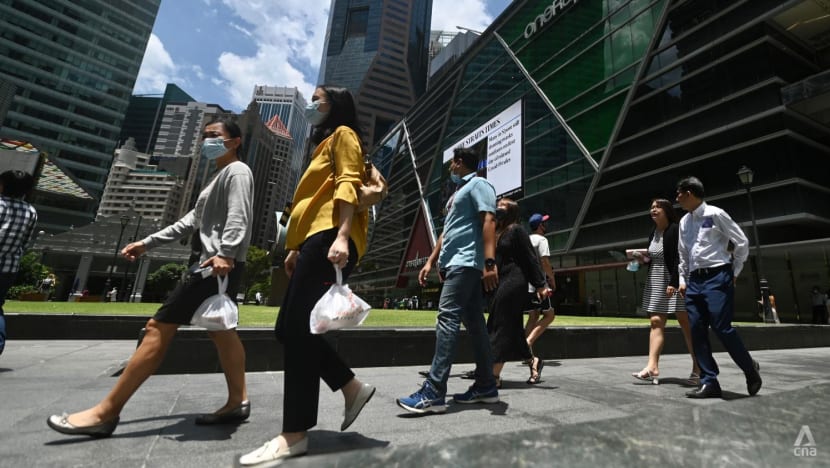Commentary: After 5 rounds of tightening, is there no other choice for MAS but to stay aggressive on monetary policy?
Core inflation was initially supposed to have peaked around the mid of this year and stabilised in the second half. This timeline has now been pushed into 2023, notes OCBC’s Selena Ling.

People seen at the central business district in Singapore on Mar 29, 2022. (Photo: CNA/Marcus Mark Ramos)
SINGAPORE: Singapore’s central bank on Friday (Oct 14) tightened monetary policy for the fifth consecutive time in 12 months to dampen inflation that’s inching towards a 14-year high.
The latest tightening took the form of a re-centering of the mid-point of the exchange rate policy band to its prevailing level, which is estimated at around 2 per cent above parity pre-announcement.
This should not be interpreted as a dovish tightening. Policymakers could be reserving ammunition for another day down the road.
The reason is simple – the Monetary Authority of Singapore (MAS) has revised up its 2022 headline and core inflation forecasts to 6 per cent and 4 per cent respectively and guided that both would remain elevated into 2023 at 5.5 to 6.5 per cent and 3.5 to 4.5 per cent respectively.
In addition, there is still upside inflation risks, potentially arising from fresh shocks to commodity prices as well as second round effects due to prolonged inflation.
If you recall, core inflation was initially supposed to have peaked around the mid of this year and stabilised in the second half of the year. This timeline has now been pushed into 2023.
Is there is really no choice but for central banks to stay aggressive on the monetary policy front to curb inflation? How will this impact businesses and consumers going forward?
CENTRAL BANK DYNAMICS
First thing to note is that unlike most central banks, MAS does not run an interest rate policy, but an exchange rate policy that helps to manage imported inflation by strengthening the trade-weighted Singapore dollar.
Second, the reality is that the world has faced both supply shocks, initially induced by the COVID-19 pandemic lockdowns but more recently due to the Russia-Ukraine war and also US-China rivalry over advanced manufacturing capabilities such as semiconductors.
So, while tightening monetary policy can dampen demand, it will not directly address supply-side constraints.
Moreover, relative central bank dynamics also matter.
While MAS was early to start tightening the S$NEER policy back in October 2021 and has done five rounds of tightening, it is also noteworthy that the US Federal Reserve has been aggressively frontloading its interest rate hikes in three back-to-back 75-basis-point hikes. In the past eight months alone, the Fed has raised rates by a total of 300 basis points, or 3 per cent.
What this means is that businesses that import intermediate inputs may benefit from a stronger Singapore dollar, which has appreciated against many regional currencies. But this is not the case against the US dollar.
For exporters, those targeting the US market will be less impacted, but those selling to regional markets may face some competitive pressures.
For Singaporeans looking to travel or studying overseas, they may also celebrate the stronger Singdollar, especially when headed to Japan, Europe or the UK.
GEOPOLITICAL UNCERTAINTIES, SLOWDOWN OF MAJOR ECONOMIES
GST is set to increase from 7 per cent to 8 per cent in January 2023. While the 1 percentage point GST hike is likely to result in a one-off step-up in price level, MAS tips the effect on inflation to be transitory, and core inflation will stay high in the first half of 2023 before slowing in the second half.
But this is also subject to a significant level of uncertainty since the Russia-Ukraine war does not appear to be headed for a resolution, and it remains to be seen how fast the foreign manpower pipeline can be ramped up to alleviate the tight domestic labour market and in turn wage pressures.
In the meantime, global and domestic growth prospects have dimmed. A synchronised slowdown of the major economies including the US, Eurozone, UK and China is already under way.
If inflation remains high, a restrictive monetary policy tightening could be pushing on a string.
Singapore’s growth prognosis for 2023 is far below trend growth and could cause the mildly positive output gap to reverse.
To put it simply, there is clear downside risk for growth from here. Stepping on the brakes make economic sense when growth momentum remains healthy, but GDP growth is likely to continue to decelerate into the final quarter of 2022.
Heading into 2023, fiscal policy may have to step up to cushion cost-of-living issues for households yet again.
On Friday, the Government announced another S$1.5 billion support package to help Singaporeans cope with persistent inflation.
This includes up to S$500 in cash to help 2.5 million individuals with an assessable income of S$100,000 and below for Year of Assessment 2022, on top of additional transport subsidy of about S$200 million next year to cover the impending 10.6 per cent hike in public transport fares, as well as 600,000 public transport vouchers worth S$30 for each resident household with a monthly household income of not exceeding S$1,600 per person.
Underpinning the cost pressures into next year include the continued pass-through from global and domestic supply chains into end-consumer prices.
As forewarned by MAS, businesses will face higher utility and raw material costs as contracts are renewed even though energy and food commodities have moderated from their year-to-date peaks.
In addition, while the pace of domestic labour cost increases will moderate over the course of 2023, it is likely to remain above its historical average.
So robust wage increases are both boon and bane – boon to workers who are facing increased spending bills due to inflation, but bane to businesses who may not be able to fully pass on the cumulative cost increases. This probably sets the stage for Budget 2023 to play a more significant role, given tax revenues have been more buoyant of late and the GST hike is impending.
WHITHER SHORT-TERM INTEREST RATES?
While the stronger S$NEER policy could theoretically dampen the pass-through from higher USD rates to SGD rates, nevertheless SGD rates may track USD rates more closely from here.
The US Federal Reserve is widely anticipated to implement its fourth hike of 75 basis points come November before tapering down to a 50-basis point hike in December.
MAS on the other hand, has its next scheduled meeting only in April 2023, with a reduced probability of another off-cycle move coming on the back of five such tightening moves already.
In turn, there could be further upside risks to local domestic interest rates in the interim.
Borrowers could face further upward pressure for mortgage rates, but savers may cheer the higher returns from savings and investments.
In summary, depending on whether you are a saver or borrower, an exporter or importer, “it was the best of times, it was the worst of times,” as in the wise words of Charles Dickens.
Selena Ling is the Chief Economist and Head of Global Treasury Research and Strategy at OCBC Bank.






















